Lecture 10 - Ptolemy and Copernicus (2/5/96)
Seeds: Chapter 4
- The Library at Alexandria
- Egypt conquered by Alexander the Great (d.323 BC), set up
Alexandria as capital
- Ptolemy I, first satrap (then king) of Egypt after Alexander's
death, founds Library. Beginning of Ptolemies as dynasty.
- The Great Libraray functions as center for Hellenic learning
(Aristarchus, Hipparchus, Ptolemy)
- Library survives fires set by Julius Caesar in 47 BC. End of
Ptolemy dynasty with Cleopatra VII (d.30 BC).
- Ptolemy, the last great Greek astronomer, around AD 140
- Library destroyed in AD 391
- Ptolemy
- Claudius Ptolemaeus (Ptolemy), not one of the Ptolemies that
ruled Egypt earlier (note Roman name), around AD 140. Virtually
nothing is known of his life.
- The last great Greek (Roman) astronomer.
- Compiled 13 volumes of Greco-Roman astronomy, including his
own calculations, called Mathematical Syntaxis, later
known by its Arabicised name The Almagest
- Made new measurement of distance to Moon using parallax, found
it to be 59 Earth radii (correct value is 60).
- Mostly known for his geocentric cosmology
- Also developed mystical principles of Natal Astrology
based upon the configuration of the planets in the sky at
the time of birth (Zodiac and Houses) still in use today
- Ptolemy's Cosmology
- Started from Aristotlean cosmology of crystal spheres centered around
the Earth
- Compiled many previous and his own observations of the positions of
the Sun, Moon, and planets. Tried to make a model to fit these
measurements.
- Combination of uniform circular motions around epicycle,
orbiting Earth on an eccentric called a deferent
- Epicycle needed to explain retrograde motion, where planets
now known to be outside Earth's orbit are seen to reverse direction
of motion across the sky.
- Retrograde motion due to differing speeds in heliocentric orbits of
Earth and outer planets (Earth faster), but needed extra loops
(epicycles) in geocentric model.
- Motion of epicycle on deferent with uniform circular velocity about
equant on opposite side of eccentric center from Earth.
This was needed to explain the changes in orbital speed observed
(now known to be due to elliptic orbits, as we will see from Kepler).
- Reproduced observed motions of planets fairly accurately, though
with very complicated model. A tribute to Ptolemy's mathematical
skills that he could make this work!
- Although this model was able to reproduce the observed motions, it
did not reflect the underlying physics --- Ptolemy himself may have
thought of it only as a mathematical model, like a computer program
- Model parameters and constants had to be continually updated by
later Arabic and Christian astronomers, as errors accumulated
- Ptolemy's version of the Aristotlean cosmology was accepted as
absolute authority by the Catholic Church until the
Copernican Revolution in the 17th century!
- Copernicus
- Nicholaus Copernicus (Polish born Mikolaj Kopernik) (b.1473 -
d.1543)
- trained in law and medecine but interests were in astronomy and
mathematics
- developed (redisovered?) heliocentric model
- He finally published his work in the book "De Revolutionibus"
("On the Revolutions") which came out the year of his death (1543).
The rest of the title "of the Heavenly Spheres" was deleted by his
publisher for some obscure reason.
- Previously published his heliocentric ideas anonymously in the
so-called "Little Commentary", which largely went un-noticed.
- Catholic Church knew of his work and was interested, but he escaped
persecution that would befall later proponents of his model
- modeled revolution of Earth about Sun plus rotation of the Earth
about its axis
- had 6 planets orbiting Sun in correct order - Mercury, Venus, Earth,
Mars, Jupiter, and Saturn
- worked out correct relative scale for solar system (see below)
- but retained idea of uniform motion on circular orbits so
his model was less accurate than Ptolemy's
- the scale of the orbital distances from Sun easily determined by
measuring the elongations, the angle between the planet and
the Sun as seen from Earth, at various points and times in their
orbits
- The orbits of the inferior planets, the inner planets
Mercury and Venus inside the orbit of the Earth, can be measured
by the angle of the greatest elongation (see
previous lecture).
- The cardinal points in inferior planetary orbits as seen from the
Earth:
- Inferior Conjunction - between the Earth and the Sun
- Superior Conjunction - on the other side of the Sun
- Greatest Western Elongation - largest angle planet
makes to West of Sun
- Greatest Eastern Elongation - largest angle planet
makes to East of Sun
- The superior planets are farther away from the Sun than
the Earth (Mars, Jupiter, Saturn)
- The cardinal points in superior planetary orbits as seen from the
Earth:
- Conjunction - on the other side of (behind) the Sun
(0 degrees elongation)
- Opposition - opposite Sun in sky (180 degrees
elongation)
- Quadrature - the two points where the planet is at
right angles to the Sun in the sky (elongation +/- 90
degrees)
Next Lecture -
Copernicus and the birth of Astronomy as a Science
The Library at Alexandria
Ptolemy
Ptolemy's Cosmology
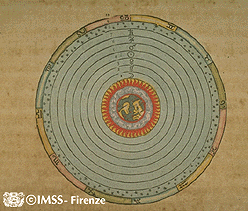
Ptolemy's (Aristotlean) Cosmos:
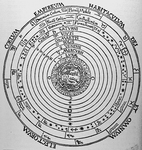
The epicycle and deferent:
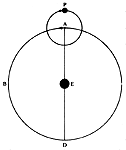
The eccentric:
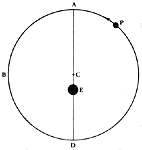
The equant:
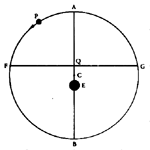
The Ptolemaic Orbit:
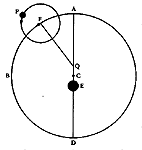
Copernicus
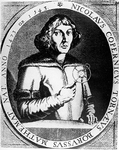
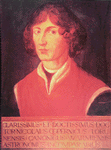
The Copernican Solar System from De Revolutionibus:

Thomas Digges' map of the Copernican Universe:
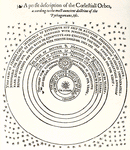
Configurations of Planets with respect to the Sun and Earth:

Go to Previous Lecture ----
Go to Next Lecture
Back to the Lecture Notes Index
Back to the ASTR001/Sec3 Page
Steven T. Myers - Last revised 06Feb96











